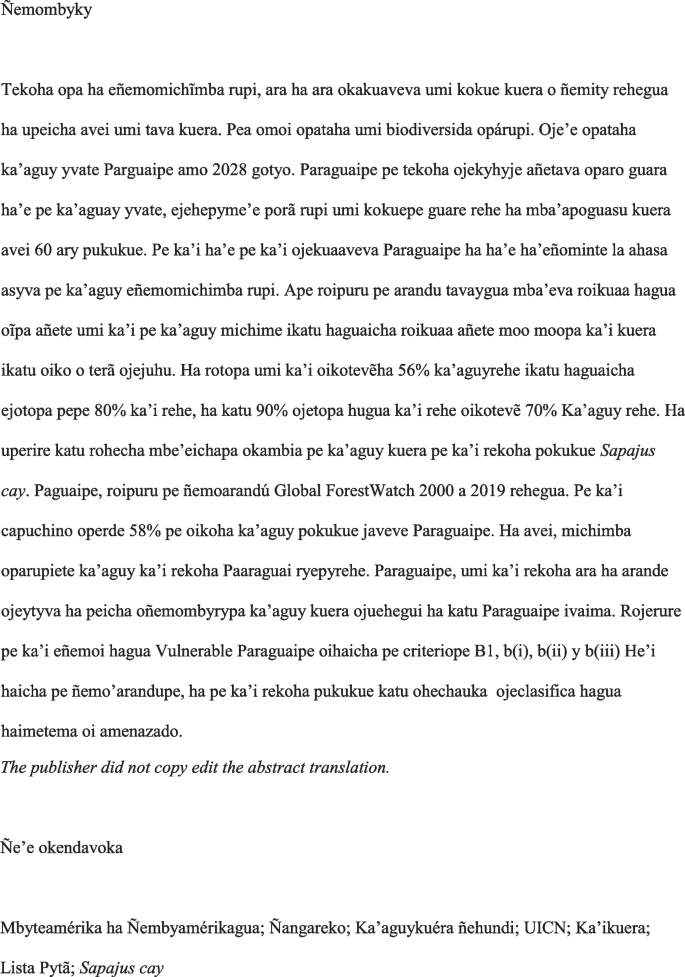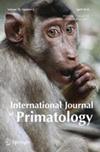The Hooded Capuchin Monkey (Sapajus cay) is Vulnerable in Paraguay and at Least Near Threatened Globally According to Red List Criteria
IF 1.8
3区 生物学
Q1 ZOOLOGY
引用次数: 0
Abstract
Abstract Habitat loss and fragmentation, particularly because of agrarian and urban expansions, are threatening biodiversity worldwide. Paraguay is predicted to lose all its primary moist forests by 2028. The most endangered habitat in Paraguay is the Upper Paraná Atlantic Forest (BAAPA), which has been decimated by industrial agriculture in the past 60 years. The hooded capuchin ( Sapajus cay ) is the best-known Paraguayan primate and the only species mostly restricted to the remaining BAAPA. We used local (defined as people living in Paraguay) knowledge about the known presence of the species in a habitat fragment to assess whether species’ presence was associated with forest cover in fragments by using a binomial general linear model (GLM). Using the results of the GLM, we then assessed how forest cover changed through the hooded capuchin range and its predicted range in Paraguay using Global ForestWatch forest cover prediction for 2000 to 2019. The GLM showed that the presence of hooded capuchins required predominance of forest cover with the monkey being 80% likely to be present for 56% cover and 90% for 70% cover. The capuchin has lost 23% of highly suitable habitat across its whole range and 58% in Paraguay. Suitable habitat for hooded capuchin monkeys is, therefore, decreasing across the full extent of the species. In Paraguay, the remaining habitat is being fragmented and degraded and distance between fragments is increasing. Because the situation in Paraguay is critical, we recommend that the capuchin is classified as Vulnerable by the International Union for the Conservation of Nature and Natural Resources (IUCN) Red List at a national level under criterion B1, b(i), b(ii), and b(iii). Predictions across the species range warrant at least a classification of Near Threatened for the species. These results demonstrate that the conservation situation faced by a primate species can differ greatly depending on local, national, and range wide political and social situations. Therefore, we recommend that national assessments are performed for species that are found in multiple countries in order to gain a true picture of threats a species faces.

兜帽卷尾猴(Sapajus cay)在巴拉圭是脆弱的,根据红色名录标准,至少在全球范围内接近受到威胁
栖息地的丧失和破碎化,特别是由于农业和城市的扩张,正在威胁着世界范围内的生物多样性。预计到2028年,巴拉圭将失去所有的原始湿润森林。巴拉圭最濒危的栖息地是上巴拉南大西洋森林(BAAPA),在过去的60年里,它被工业化农业摧毁了。兜帽卷尾猴(Sapajus cay)是巴拉圭最著名的灵长类动物,也是唯一一种主要局限于剩余BAAPA的物种。我们使用当地(定义为生活在巴拉圭的人)关于物种在栖息地碎片中已知存在的知识,通过使用二项一般线性模型(GLM)来评估物种的存在是否与碎片中的森林覆盖有关。利用GLM的结果,我们利用全球森林观察2000年至2019年的森林覆盖预测,评估了巴拉圭森林覆盖在兜帽卷尾猴范围及其预测范围内的变化情况。GLM显示,蒙头卷尾猴的存在需要森林覆盖率的优势,在56%的覆盖率下,蒙头卷尾猴出现的可能性为80%,在70%的覆盖率下,蒙头卷尾猴出现的可能性为90%。卷尾猴失去了整个栖息地中23%的高度适宜栖息地,在巴拉圭失去了58%。因此,在整个物种范围内,适合蒙头卷尾猴的栖息地正在减少。在巴拉圭,剩余的生境正在破碎和退化,碎片之间的距离正在增加。由于巴拉圭的情况非常危急,我们建议国际自然与自然资源保护联盟(IUCN)红色名录将卷尾猴列为国家一级的易危物种,标准为B1、b(i)、b(ii)和b(iii)。对整个物种范围的预测至少保证了该物种的近危分类。这些结果表明,灵长类物种面临的保护状况可能会因地方、国家和广泛的政治和社会状况而有很大差异。因此,我们建议对在多个国家发现的物种进行国家评估,以获得物种面临威胁的真实情况。
本文章由计算机程序翻译,如有差异,请以英文原文为准。
求助全文
约1分钟内获得全文
求助全文
来源期刊
CiteScore
4.10
自引率
16.00%
发文量
68
审稿时长
6-12 weeks
期刊介绍:
The International Journal of Primatology is a multidisciplinary forum devoted to the dissemination of current research in fundamental primatology. Publishing peer-reviewed, high-quality original articles which feature primates, the journal gathers laboratory and field studies from such diverse disciplines as anthropology, anatomy, ecology, ethology, paleontology, psychology, sociology, and zoology.

 求助内容:
求助内容: 应助结果提醒方式:
应助结果提醒方式:


